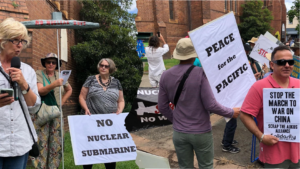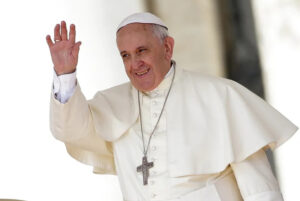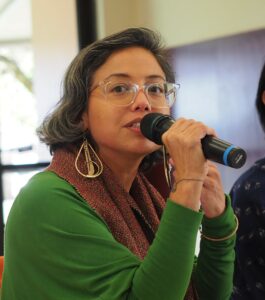
‘Our human community bears, in its memory and its flesh, the scars of ever more devastating wars and conflicts that affect especially the poor and the vulnerable. Entire nations find it difficult to break free of the chains of exploitation and corruption that fuel hatred and violence’ – Pope Francis 2021
 The leading measure of world-wide peace, The Global Peace Index, affirms that sentiment. Since the Index began sixteen years ago there has been a continual decline in global peace. In 2023 the average level of global peace fell by 0.03%, although this is a slight deterioration, it is the eleventh deterioration in peacefulness over the last fourteen annual indexes and the 9th consecutive decline. This is in no short order from rising tensions and civil unrest post-covid. Likewise trends indicate that a nation becoming peaceful is a long and focused effort while becoming less peaceful happens rapidly and intensely. The 2023 report has a powerful example of this in Ukraine, which due to conflict with Russia fell from 143rd to 157th in a single year.
The leading measure of world-wide peace, The Global Peace Index, affirms that sentiment. Since the Index began sixteen years ago there has been a continual decline in global peace. In 2023 the average level of global peace fell by 0.03%, although this is a slight deterioration, it is the eleventh deterioration in peacefulness over the last fourteen annual indexes and the 9th consecutive decline. This is in no short order from rising tensions and civil unrest post-covid. Likewise trends indicate that a nation becoming peaceful is a long and focused effort while becoming less peaceful happens rapidly and intensely. The 2023 report has a powerful example of this in Ukraine, which due to conflict with Russia fell from 143rd to 157th in a single year.
The Index measures peace internally and externally across 23 indicators. Some of these include: level of perceived criminality in society; number of homicides; ease of access to weapons and small arms; political terror scale; number and duration of internal conflicts; military expenditure as proportion of GDP; financial contributions to UN peacekeeping; relations with neighboring countries; and number, role and duration of external conflict involvements.

As of 2023, the ten least peaceful countries in order are:
| 163 | Afghanistan |
| 162 | Yemen |
| 161 | Syria |
| 160 | South Sudan |
| 159 | Democratic Republic of Congo |
| 158 | Russia |
| 157 | Ukraine |
| 156 | Somalia |
| 155 | Sudan |
| 154 | Iraq |
And the ten most peaceful countries in order are:
| 1 | Iceland |
| 2 | Denmark |
| 3 | Ireland |
| 4 | New Zealand |
| 5 | Austria |
| 6 | Singapore |
| 7 | Portugal |
| 8 | Slovenia |
| 9 | Japan |
| 10 | Switzerland |
Australia ranked 22nd out of the 163 countries. On the overwhelming majority of individual indicators we scored in the more peaceful range, with one extreme outlier. On weapons imports, defined as ‘the transfer of equipment or technology from one country, rebel force or international organization, to another country, rebel force or international organization’, we received our worst score of 4.5/5, having risen from 4.2 just 3 years ago. As of 2022, Australia makes up 5% of all global arms imports and has forecasted $270 billion dollars in investment for defense capabilities in the next decade.
One of the most worrying pieces of data from the Index was the growth of the ‘peace inequality gap’, that is, more peaceful countries are growing increasingly peaceful but those experiencing conflict are continually deteriorating. This causes some regions to have a disproportionate effect on overall global peace levels. Some of these regions include Ethiopia, Ukraine, Myanmar, Israel and South Africa. Unsurprisingly, Afghanistan is currently considered the least peaceful and most dangerous nation on Earth. Globally, the deterioration of peace was largely the result of increased territorial conflict, civil tensions and increased political instability. This has resulted in 2023 having the most conflict deaths this century, a 96% increase from just last year, with the highest contributing country being Ethiopia.
What does this cost us?
In human terms the price of conflict on this scale is enormous. The number of battle related deaths is at an all time high largely because of the conflicts within Ukraine and Ethiopia, reaching almost 300,000 casualties in 2023 alone. The loss of civilian life, however, has grown exponentially not just in the last ten years but right across the twentieth century. In 1915 just 15% of all war-related deaths were civilians, but by the late 1990s that number was a staggering 90%.
 Humans have paid and continue to pay too high a price for conflict in other ways as well. In any conflict people suffer from most if not all of the following: increased poverty, generational loss of education; loss of work; increased emotional and physical suffering; shorter life expectancy; very low to no access to healthcare; malnutrition and loss of a social welfare net due to the demise or decline of governance infrastructure.
Humans have paid and continue to pay too high a price for conflict in other ways as well. In any conflict people suffer from most if not all of the following: increased poverty, generational loss of education; loss of work; increased emotional and physical suffering; shorter life expectancy; very low to no access to healthcare; malnutrition and loss of a social welfare net due to the demise or decline of governance infrastructure.
One of the most appalling effects of conflict is the number of people who have become refugees or internally displaced persons (people who have no homes in their country but have not moved beyond national borders). That number is at its highest in 60 years and it almost doubled from 2007 to 2015. By 2016 it was approximately 60 million people. There are nine countries with more than 10 percent of their population classified as refugees or internally displaced persons with Somalia and South Sudan having more than 20 per cent of their population displaced. At the time Syria had the highest number of displaced people with a whopping 60 percent of its population unsettled; that is about 11.3 million people (4.8million fleeing externally, 6.5 million internally). In 2023, a similar level of displacement from the Russia-Ukraine war occurred with the global peace index finding 65% of Ukrainian men aged 20-24 have fled the country, or have died in war.

In raw economic terms conflict is extremely expensive. It disrupts economies, destroys them in some cases, and conflict itself is expensive to fund. The Global Peace Index found that in 2023 the global economic impact of violence cost $17.5 trillion US dollars or 13% of the global GDP. That is almost twice as much money as the investment and operations of health services during the most expensive year of the covid pandemic – Globally! Where 9.2 trillion US dollars was spent internationally.
MORE INFORMATION:
- To find out what the Church teaches about peace and war click here.
- To learn more about peace and conflict in Australia and how you can get involved click here.
Sources: All data sources are embedded in the text, please follow these links to be redirected to original source and further information. Multimedia, tables and info-graphics all courtesy the Global Peace Index, Peace and Economics Institute.
Page last updated April 2024
